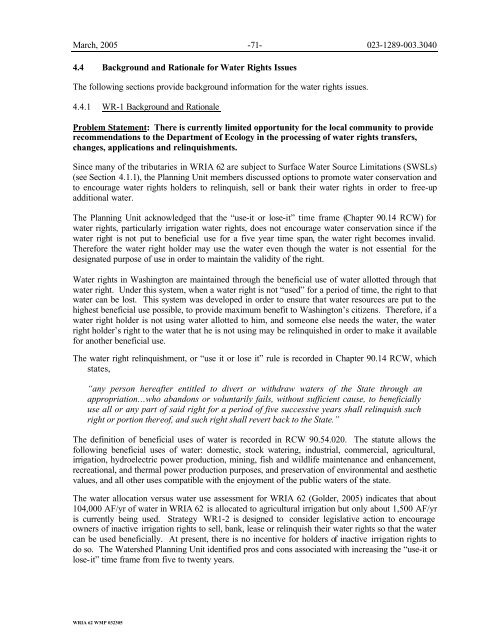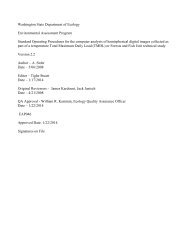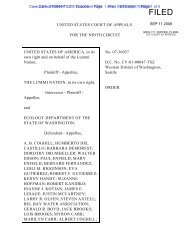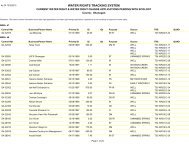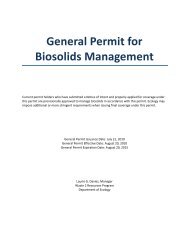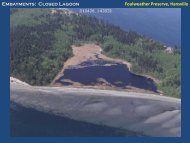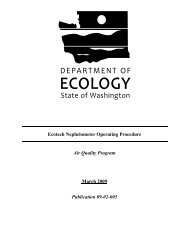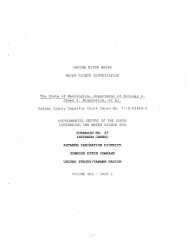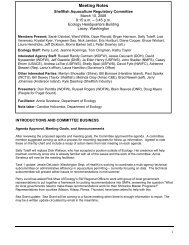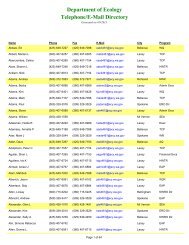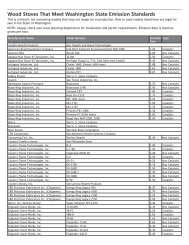WRIA 62 WMP 032305 - Washington State Department of Ecology
WRIA 62 WMP 032305 - Washington State Department of Ecology
WRIA 62 WMP 032305 - Washington State Department of Ecology
You also want an ePaper? Increase the reach of your titles
YUMPU automatically turns print PDFs into web optimized ePapers that Google loves.
March, 2005 -71- 023-1289-003.3040<br />
4.4 Background and Rationale for Water Rights Issues<br />
The following sections provide background information for the water rights issues.<br />
4.4.1 WR-1 Background and Rationale<br />
Problem <strong>State</strong>ment: There is currently limited opportunity for the local community to provide<br />
recommendations to the <strong>Department</strong> <strong>of</strong> <strong>Ecology</strong> in the processing <strong>of</strong> water rights transfers,<br />
changes, applications and relinquishments.<br />
Since many <strong>of</strong> the tributaries in <strong>WRIA</strong> <strong>62</strong> are subject to Surface Water Source Limitations (SWSLs)<br />
(see Section 4.1.1), the Planning Unit members discussed options to promote water conservation and<br />
to encourage water rights holders to relinquish, sell or bank their water rights in order to free-up<br />
additional water.<br />
The Planning Unit acknowledged that the “use-it or lose-it” time frame (Chapter 90.14 RCW) for<br />
water rights, particularly irrigation water rights, does not encourage water conservation since if the<br />
water right is not put to beneficial use for a five year time span, the water right becomes invalid.<br />
Therefore the water right holder may use the water even though the water is not essential for the<br />
designated purpose <strong>of</strong> use in order to maintain the validity <strong>of</strong> the right.<br />
Water rights in <strong>Washington</strong> are maintained through the beneficial use <strong>of</strong> water allotted through that<br />
water right. Under this system, when a water right is not “used” for a period <strong>of</strong> time, the right to that<br />
water can be lost. This system was developed in order to ensure that water resources are put to the<br />
highest beneficial use possible, to provide maximum benefit to <strong>Washington</strong>’s citizens. Therefore, if a<br />
water right holder is not using water allotted to him, and someone else needs the water, the water<br />
right holder’s right to the water that he is not using may be relinquished in order to make it available<br />
for another beneficial use.<br />
The water right relinquishment, or “use it or lose it” rule is recorded in Chapter 90.14 RCW, which<br />
states,<br />
“any person hereafter entitled to divert or withdraw waters <strong>of</strong> the <strong>State</strong> through an<br />
appropriation…who abandons or voluntarily fails, without sufficient cause, to beneficially<br />
use all or any part <strong>of</strong> said right for a period <strong>of</strong> five successive years shall relinquish such<br />
right or portion there<strong>of</strong>, and such right shall revert back to the <strong>State</strong>.”<br />
The definition <strong>of</strong> beneficial uses <strong>of</strong> water is recorded in RCW 90.54.020. The statute allows the<br />
following beneficial uses <strong>of</strong> water: domestic, stock watering, industrial, commercial, agricultural,<br />
irrigation, hydroelectric power production, mining, fish and wildlife maintenance and enhancement,<br />
recreational, and thermal power production purposes, and preservation <strong>of</strong> environmental and aesthetic<br />
values, and all other uses compatible with the enjoyment <strong>of</strong> the public waters <strong>of</strong> the state.<br />
The water allocation versus water use assessment for <strong>WRIA</strong> <strong>62</strong> (Golder, 2005) indicates that about<br />
104,000 AF/yr <strong>of</strong> water in <strong>WRIA</strong> <strong>62</strong> is allocated to agricultural irrigation but only about 1,500 AF/yr<br />
is currently being used. Strategy WR1-2 is designed to consider legislative action to encourage<br />
owners <strong>of</strong> inactive irrigation rights to sell, bank, lease or relinquish their water rights so that the water<br />
can be used beneficially. At present, there is no incentive for holders <strong>of</strong> inactive irrigation rights to<br />
do so. The Watershed Planning Unit identified pros and cons associated with increasing the “use-it or<br />
lose-it” time frame from five to twenty years.<br />
<strong>WRIA</strong> <strong>62</strong> <strong>WMP</strong> <strong>032305</strong>


